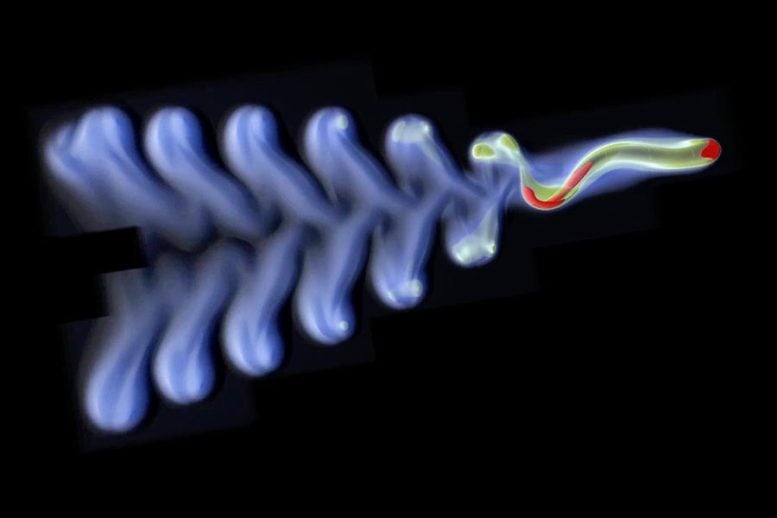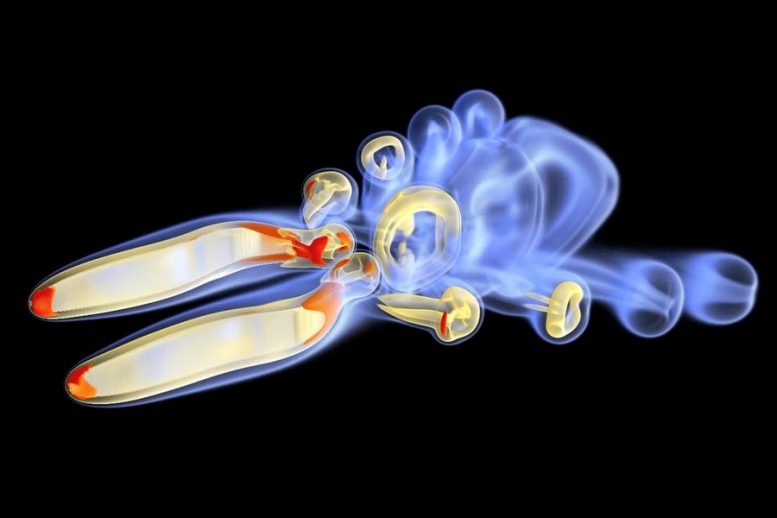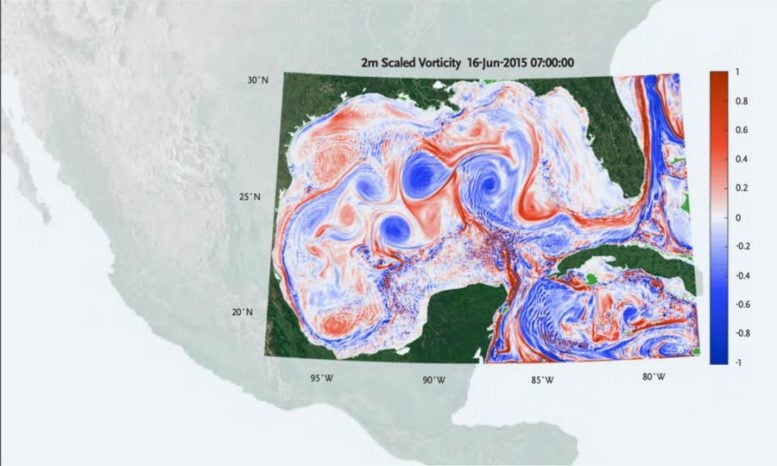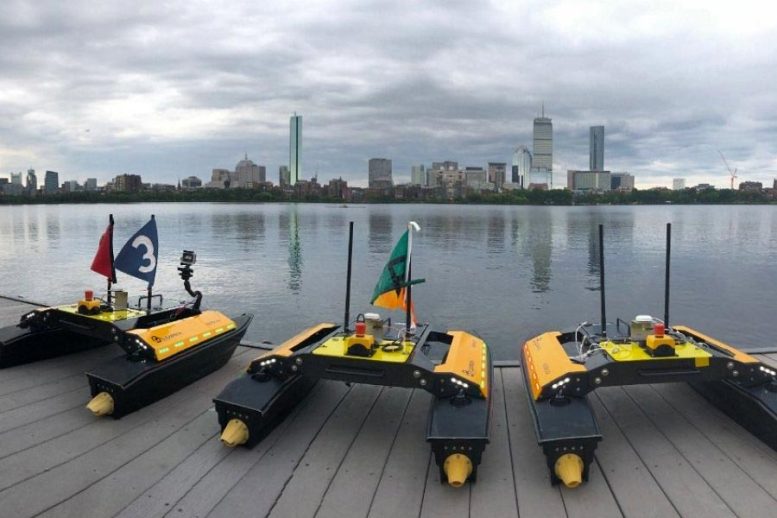By

Assistant Professor Wim van Rees and his team have developed simulations of self-propelled undulatory swimmers to better understand how fish-like deformable fins could improve propulsion in underwater devices, seen here in a top-down view. Credit: Image courtesy of MIT van Rees Lab
MIT ocean and mechanical engineers are using advances in scientific computing to address the ocean’s many challenges, and seize its opportunities.
There are few environments as unforgiving as the ocean. Its unpredictable weather patterns and limitations in terms of communications have left large swaths of the ocean unexplored and shrouded in mystery.
“The ocean is a fascinating environment with a number of current challenges like microplastics, algae blooms, coral bleaching, and rising temperatures,” says Wim van Rees, the ABS Career Development Professor at MIT. “At the same time, the ocean holds countless opportunities — from aquaculture to energy harvesting and exploring the many ocean creatures we haven’t discovered yet.”
Ocean engineers and mechanical engineers, like van Rees, are using advances in scientific computing to address the ocean’s many challenges, and seize its opportunities. These researchers are developing technologies to better understand our oceans, and how both organisms and human-made vehicles can move within them, from the micro scale to the macro scale.

Assistant Professor Wim van Rees and his team have developed simulations of self-propelled undulatory swimmers to better understand how fish-like deformable fins could improve propulsion in underwater devices, seen here as two fish side-by-side. Credit: Image courtesy of MIT van Rees Lab
Bio-inspired underwater devices
An intricate dance takes place as fish dart through water. Flexible fins flap within currents of water, leaving a trail of eddies in their wake.
“Fish have intricate internal musculature to adapt the precise shape of their bodies and fins. This allows them to propel themselves in many different ways, well beyond what any man-made vehicle can do in terms of maneuverability, agility, or adaptivity,” explains van Rees.
According to van Rees, thanks to advances in additive manufacturing, optimization techniques, and machine learning, we are closer than ever to replicating flexible and morphing fish fins for use in underwater robotics. As such, there is a greater need to understand how these soft fins impact propulsion.
Van Rees and his team are developing and using numerical simulation approaches to explore the design space for underwater devices that have an increase in degrees of freedom, for instance due to fish-like, deformable fins.

Graduate student Abhinav Gupta and Professor Pierre Lermusiaux have developed a new machine learning framework to help make up for the lack of resolution or accuracy in existing dynamical system models. Their framework can be used for a number of applications, including improved predictions of Loop Current eddies around oil rigs in the Gulf of Mexico. Credit: Image courtesy of the MIT MSEAS Lab
These simulations help the team better understand the interplay between the fluid and structural mechanics of fish’s soft, flexible fins as they move through a fluid flow. As a result, they are able to better understand how fin shape deformations can harm or improve swimming performance. “By developing accurate numerical techniques and scalable parallel implementations, we can use supercomputers to resolve what exactly happens at this interface between the flow and the structure,” adds van Rees.
Through combining his simulation algorithms for flexible underwater structures with optimization and machine learning techniques, van Rees aims to develop an automated design tool for a new generation of autonomous underwater devices. This tool could help engineers and designers develop, for example, robotic fins and underwater vehicles that can smartly adapt their shape to better achieve their immediate operational goals — whether it’s swimming faster and more efficiently or performing maneuvering operations.
“We can use this optimization and AI to do inverse design inside the whole parameter space and create smart, adaptable devices from scratch, or use accurate individual simulations to identify the physical principles that determine why one shape performs better than another,” explains van Rees.
Swarming algorithms for robotic vehicles
Like van Rees, Principal Research Scientist Michael Benjamin wants to improve the way vehicles maneuver through the water. In 2006, then a postdoc at MIT, Benjamin launched an open-source software project for an autonomous helm technology he developed. The software, which has been used by companies like Sea Machines, BAE/Riptide, Thales UK, and Rolls Royce, as well as the United States Navy, uses a novel method of multi-objective optimization. This optimization method, developed by Benjamin during his PhD work, enables a vehicle to autonomously choose the heading, speed, depth, and direction it should go in to achieve multiple simultaneous objectives.

Michael Benjamin has developed swarming algorithms that enable uncrewed vehicles, like the ones pictured, to disperse in an optimal distribution and avoid collisions. Credit: Michael Benjamin
Now, Benjamin is taking this technology a step further by developing swarming and obstacle-avoidance algorithms. These algorithms would enable dozens of uncrewed vehicles to communicate with one another and explore a given part of the ocean.
To start, Benjamin is looking at how to best disperse autonomous vehicles in the ocean.
“Let’s suppose you want to launch 50 vehicles in a section of the Sea of Japan. We want to know: Does it make sense to drop all 50 vehicles at one spot, or have a mothership drop them off at certain points throughout a given area?” explains Benjamin.
He and his team have developed algorithms that answer this question. Using swarming technology, each vehicle periodically communicates its location to other vehicles nearby. Benjamin’s software enables these vehicles to disperse in an optimal distribution for the portion of the ocean in which they are operating.
Central to the success of the swarming vehicles is the ability to avoid collisions. Collision avoidance is complicated by international maritime rules known as COLREGS — or “Collision Regulations.” These rules determine which vehicles have the “right of way” when crossing paths, posing a unique challenge for Benjamin’s swarming algorithms.
The COLREGS are written from the perspective of avoiding another single contact, but Benjamin’s swarming algorithm had to account for multiple unpiloted vehicles trying to avoid colliding with one another.
To tackle this problem, Benjamin and his team created a multi-object optimization algorithm that ranked specific maneuvers on a scale from zero to 100. A zero would be a direct collision, while 100 would mean the vehicles completely avoid collision.
“Our software is the only marine software where multi-objective optimization is the core mathematical basis for decision-making,” says Benjamin.
While researchers like Benjamin and van Rees use machine learning and multi-objective optimization to address the complexity of vehicles moving through ocean environments, others like Pierre Lermusiaux, the Nam Pyo Suh Professor at MIT, use machine learning to better understand the ocean environment itself.
Improving ocean modeling and predictions
Oceans are perhaps the best example of what’s known as a complex dynamical system. Fluid dynamics, changing tides, weather patterns, and climate change make the ocean an unpredictable environment that is different from one moment to the next. The ever-changing nature of the ocean environment can make forecasting incredibly difficult.
Researchers have been using dynamical system models to make predictions for ocean environments, but as Lermusiaux explains, these models have their limitations.
“You can’t account for every molecule of water in the ocean when developing models. The resolution and accuracy of models, and the ocean measurements are limited. There could be a model data point every 100 meters, every kilometer, or, if you are looking at climate models of the global ocean, you may have a data point every 10 kilometers or so. That can have a large impact on the accuracy of your prediction,” explains Lermusiaux.
Graduate student Abhinav Gupta and Lermusiaux have developed a new machine-learning framework to help make up for the lack of resolution or accuracy in these models. Their algorithm takes a simple model with low resolution and can fill in the gaps, emulating a more accurate, complex model with a high degree of resolution.
For the first time, Gupta and Lermusiaux’s framework learns and introduces time delays in existing approximate models to improve their predictive capabilities.
“Things in the natural world don’t happen instantaneously; however, all the prevalent models assume things are happening in real time,” says Gupta. “To make an approximate model more accurate, the machine learning and data you are inputting into the equation need to represent the effects of past states on the future prediction.”
The team’s “neural closure model,” which accounts for these delays, could potentially lead to improved predictions for things such as a Loop Current eddy hitting an oil rig in the Gulf of Mexico, or the amount of phytoplankton in a given part of the ocean.
As computing technologies such as Gupta and Lermusiaux’s neural closure model continue to improve and advance, researchers can start unlocking more of the ocean’s mysteries and develop solutions to the many challenges our oceans face.
Credit: Source link





















